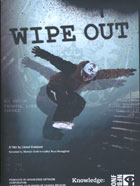
Wipe Out 2008
Distributed by National Film Board of Canada, 1123 Broadway, Suite 307, New York, NY 10010; 800-542-2164
Produced by Knowledge Network
Directed by Lionel Goddard
DVD, color, 50 min.
Jr. High - Adult
Sports, Health Sciences, Head Injury
Date Entered: 01/12/2010
Reviewed by Lori Widzinski, Health Sciences Library, University at Buffalo, State University of New YorkWith the increase in extreme sporting events in the past decade has come an increase in head injuries, particularly among male adolescents. Wipe Out profiles three young men who suffered head injuries—one while snowboarding, one skateboarding, and one in a dirt bike accident. While they have all recovered to different degrees, they illustrate the results of extreme sporting accidents that happen so quickly.
Often called an “invisible epidemic” closed head injuries, such as concussions, are increasing at an astounding rate. The effects of multiple concussions are often reported in the national sports news associated primarily with professional football and hockey players. However, a whole segment of our young adult culture is involved in various forms of thrill-seeking “extreme” sports, most of them male, that are getting hurt and irrevocably changing their lives and the lives of those around them. This film touches on the scientists that are now studying the biological basis of thrill-seeking behavior, particularly in adolescents, and what drives young men to take these risks.
Two of the men in the film, Chris Dufficy and Chris Tutin are now working to spread the word to kids about the dangers of participating in extreme sports, and promoting the use of helmets. They travel to classrooms to explain the lasting effects of brain injuries. While Chris Dufficy looks perfectly normal, he still has to deal with the consequences of multiple concussions and several broken bones from years of extreme snowboarding. Chris Tutin is a more powerful example for kids since he was left with very affected speech and physical shaking after his dirt bike plowed into a trailer when the brakes failed to engage. Both men deal with learning difficulties and emotional side effects from their injuries.
Brain injuries often alter personalities and the injured don’t seem like the same people they were before their accidents. Emotional changes occur, often resulting in angry, violent reactions; or missing a sense of personal boundaries when engaging in normal interactions. The parents of the three men in the film all speak about the wide ranging effects their child’s brain injury.
This film has all the fine qualities of National Film Board of Canada productions, and will be a good addition to school media centers in particular since the main purpose of the film is advocating helmet use and other safe practices to avoid head injuries from extreme sports. Wipe Out succeeds in its advocacy mission, but for library collections in higher education, it will be useful if paired with other programs such as Brain Injury Dialogues (2008 braininjurydialogues.org) and Life. Support. Music. (2008, Cinema Guild).